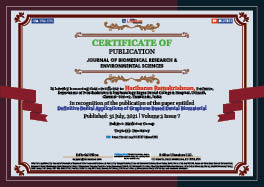> Medicine Group. 2021 July 31;2(7):652-653. doi: 10.37871/jbres1292.
Definitive Dental Applications of Graphene Based Dental Biomaterial
Hariharan Ramakrishnan1*, Surabhi Halder1 and Khalid Ghiaz2
2Professor and Head Priyadarshini dental college and hospital, Pandur, Thiruvallur, India
- Graphene oxide
- Graphite
- Polymethylmethacrylate
- Biomaterial
- Carbon
Abstract
Graphene was first identified in 2004, and it has remarkable properties. Atoms of Graphene are very tightly bonded so, like carbon nanotubes, which makes it super-strong, even more, potent than diamond. Moreover, it has good Heat conductivity, Electrical conductivity, and optical properties. Application in the dental field, especially in prosthodontics, includes the addition to Polymethylmethacrylate and improving its properties. In removable and implant prosthodontics in the last five years, this biomaterial had evoked immense research interest.
Introduction
Graphene is stiff, amazingly thin, almost completely transparent, extremely light, and a tremendous conductor of electricity and heat. It also has some highly unusual electronic properties [1,2]. It is a single layer of graphite. It has a two-dimensional crystalline structure. As in graphite, each graphene layer is formed of hexagonal “rings” of carbon, giving a honeycomb-like appearance [1,2].
General Properties
Strength and stiffness
It is both stiff and elastic. It can be stretched by a tremendous amount (20-25 percent of its original length) without breaking because the flat planes of carbon atoms in graphene can undergo flexion easily [1,3,4]. It has the tensile strength of 130 gigapascals [3,4].
Thinness and lightness
Graphene is one atom thick and also very light. The thickness of graphene is between 0.4 to 1.7 nm [3,4].
Heat conductivity
Graphene has a very high thermal conductivity. The thermal conductivity of graphene is in the range 3000 - 5000 W/mK at room temperature [3,4].
Electrical conductivity
Graphene has excellent electrical conductivity. The electric conductivity of graphene is as high as 104–105 S/m [3,4].
Optical properties
Photons can penetrate through thin layers of graphene than thick ones. Sheets of graphene have such close-knit carbon atoms that they will work like super-fine atomic nets, stopping other materials from getting through [3,4].
General Applications
• As an Energy storage unit and in solar cells
• Sensor applications
• Graphene ink
• Used in transistors and memory Flexible, and stretchable electronics, Photodetectors
Applications in Prosthodontics
1. Addition of graphene in Polymethylmethacrylate resin (PMMA) increases the resin’s mechanical properties, decreases the degree of contraction during polymerization, and exhibits better antimicrobial-adhesion effects [5]. Polymerisation of PMMA triggers an exothermic reaction. Graphene has excellent heat conductive property and causes complete polymerization with creation of a stable, compact material, with the elimination of many negative properties of acrylic like the coefficient of absorption [6]. Graphene polymer has very high flexural strength, esthetics, high superficial abrasion resistance, and after its addition, makes acrylic resin an improved material.
2. Graphene, when coated on titanium substrate, the hydrophobic character of graphene film exerted a self-cleaning effect on its surfaces, thereby decreasing the adhesion of microorganisms, which includes S. sanguinis and S. mutans [7]. Additionally, compared to titanium alone, graphene possesses osteogenic property enhancing the expression of osteogenic related genes RUNX2, COL-I, and ALP, boosting osteocalcin gene and protein expression, consequently increasing the deposition of mineralized matrix [7]. It has high flexural strength, so the impact forces on the underlying coated implant are significantly less. Graphene superstructure can act as a shock absorber, preventing high-impact forces from acting on the implant body. The entire prosthesis can also be made in a single framework [6].
Conclusion
Currently, Graphene is an exciting material for intense research both in removable prosthodontics and in Implantology. More clinical studies including randomized clinical trials with greater sample sizes and with encouraging results will enable us to understand this material in a real world setting and make it a preferred choice among clinicians.
References
- Sattar T. Current Review on Synthesis, Composites and Multifunctional Properties of Graphene. Top Curr Chem (Cham). 2019 Mar 14;377(2):10. doi: 10.1007/s41061-019-0235-6. PMID: 30874921.
- Banerjee AN. Graphene and its derivatives as biomedical materials: future prospects and challenges. Interface Focus. 2018 Jun 6;8(3):20170056. doi: 10.1098/rsfs.2017.0056. Epub 2018 Apr 20. PMID: 29696088; PMCID: PMC5915658.
- Zhu Y, Murali S, Cai W, Li X, Suk JW, Potts JR, Ruoff RS. Graphene and graphene oxide: synthesis, properties, and applications. Adv Mater. 2010 Sep 15;22(35):3906-24. doi: 10.1002/adma.201001068. Erratum in: Adv Mater. 2010 Dec 7;22(46):5226. PMID: 20706983.
- Abbasi E, Akbarzadeh A, Kouhi M, Milani M. Graphene: Synthesis, bio-applications, and properties. Artif Cells Nanomed Biotechnol. 2016;44(1):150-6. doi: 10.3109/21691401.2014.927880. Epub 2014 Jun 30. PMID: 24978443.
- Azevedo L, Antonaya-Martin JL, Molinero-Mourelle P, Del Río-Highsmith J. Improving PMMA resin using graphene oxide for a definitive prosthodontic rehabilitation - A clinical report. J Clin Exp Dent. 2019 Jul 1;11(7):e670-e674. doi: 10.4317/jced.55883. PMID: 31516667; PMCID: PMC6730997.
- Bacali C, Badea M, Moldovan M, Sarosi C, Nastase V, Baldea I, Chiorean RS, Constantiniuc M. The Influence of Graphene in Improvement of Physico-Mechanical Properties in PMMA Denture Base Resins. Materials (Basel). 2019 Jul 23;12(14):2335. doi: 10.3390/ma12142335. PMID: 31340462; PMCID: PMC6678796.
- Ge Z, Yang L, Xiao F, Wu Y, Yu T, Chen J, Lin J, Zhang Y. Graphene Family Nanomaterials: Properties and Potential Applications in Dentistry. Int J Biomater. 2018 Dec 9;2018:1539678. doi: 10.1155/2018/1539678. PMID: 30627167; PMCID: PMC6304494.
Content Alerts
SignUp to our
Content alerts.
 This work is licensed under a Creative Commons Attribution 4.0 International License.
This work is licensed under a Creative Commons Attribution 4.0 International License.








